Good Morning from Kathmandu. Please don't worry: after this post, the other team members' voices should chime in. Last night we conferred about which of us would like to write about what parts of our experience. Ella and Mary were the first to pipe up. But I'll let them (and Jenna and Reba and Ashleigh) say what they have decided as their topics.
What I chose to write about is our return to The Cave of the Snow Leopard.
Three years ago, in 2007, our Gift for the Village team became (as we explain in our documentary) the third group of climbers to reach this recently rediscovered cave, which is chiseled out of a sheer 16,000-foot cliff. The back wall of the cave is entirely covered with fresco, a thousand years old. In our documentary, we theorize about who may have painted these excellent panels, and our conclusions hint at a tremendously unexpected story about the cave's artist.
As a flightless gnat would labor with a sense of inadequacy and even deformity to climb and descend skyscraper after skyscraper, so we struggled. This ascent, or series of ascents, was the most difficult of many intense climbs, although I am not speaking exclusively about technical difficulties like elevation or angle.
Here, you do not proceed with pride, and pride is a hard backpack to leave behind. There should be no frivolity on this walk. This climb is a pilgrimage, because the cave frescoes which have watched a thousand winter blizzards swirl past are painted prayers, homages and thanks to a series of the artist's teachers. This place is a cave which honors the idea of relationship, teaching, guru wisdom, and humility.
Be quiet here. See the beautiful landscape on the way to the Cave, of course, but turn your mind toward what you do not see. Do not poeticize your lovely heartbeat or your flights of gratitude here. Do not marvel about your skin tingling or your smile broadening to fit the enormous landscape. Be quiet. Stop seeing yourself.
Tsampa has taught me this much.
To reach the Cave, you must walk for hours past Lo Monthang, which is itself described as the Holy Grail of remote places.
You must enter a tiny village and find the Keeper of the Key, a local man whose ancient, wrapped rag contains the Key to the Cliff Door. He must walk with you past the Valley of the White Rocks, where, a quarter century ago, a glacial avalanche sent down a shattering of icy river and hundreds of thousands of huge, tumbling, snow-white boulders, some like basketballs, some like elepahants.
This torrent hit Chosar Valley at midnight. Ninety percent of the homes, the animals, and the villagers were never found. The Chosar Valley, with its white boulder tombstones, covers that midnight of agony. The Keeper of the Key, walking with us, was a young child at the time. He lost most people he knew, his village, and its landscape. He told his story to Pema, who translated for us, as we walked through that Valley, the Valley of the White Shadow of Death. I could not help but think of the skeletons beneath us, in archaeopteryx positions, the fossils of a terrible night.
You walk past a sky-burial site, a long flat boulder, a little like an ossified lounge chair, shin-high. The rock would not be noticeable except for the heavy ropes that tie around it, and, since Tsampa showed us last time, for the nearby rock, under which are tucked three rustworn handmade blades belonging to the sky burial priest, and the rag-clothing he wears during the rites he perform.
In Tibet, there is a saying: Everyone should see a sky burial at least once, in order to understand impermanence.
But first, allow me to explain: in Tibetan Buddhism, there are five types of burial, to match the five elements.
Earth burials, in Upper Mustang, are virtually impossible, because there is no earth to dig. The land here is rock, or rock-silt. Water-burial isn't tasteful, because, although a chopped corpse benefits the tiny fish in the rivers here, the body pollutes the water for the villagers downstream.
Cremation, or fire-burial, is a highly respectful form, but costly to the Mustangis. Our friend Pema explained that the wood which is piled all along every Mustang home is not primarily firewood, but "our wealth, and our duty." At death-time, a family needs enough wood to cremate the body. Not having this wood is considered shameful. Upper Mustang is high-desert, and wood is rare; there are no trees to fell--only the bonsai-twisted stubs of tortured juniper or other low-scrub. But this wood is necessary for a cremation, and fire is considered extremely clean. A cremation is an honor.
There are two other kinds of burial in Tibetan Buddhism. One, the rarest, is mind-burial. Mind is the fifth element as Tibetans organize the universe. (In China, the fifth element, or sometimes the sixth, is, instead, iron.) Highly-accomplished practitioners of Buddhist mind and body control can decide consciously to leave their body in order to choose a specific rebirth. Tibetans believe in a space between death and rebirth called The Bardo. In this in-between realm, which is not a holding tank, but more like a wind-tunnel, your consciousness goes careening.
Think of your after-death consciousness as a Kleenex blown forcefully into a completely dark wind-tunnel. You go zooming and twisting and fluttering, upside-down, a parachutist without a familiar body, but with some sense of your own blind being. It is a terrifying disorienting tumble--UNLESS you have trained for it. The meditations that His Holiness the Dalai Lama does, for instance, prepare his unbodied consciousness for this ride. Only, he will be able to steer.
There are Tibetan lamas (teachers, priests) so accomplished and learned that they can not only speak to a dying person's mind as the body dies, to help instruct the mind during the transition into the windy Bardo, but who can find a consciousness even after it has tumbled and taken rebirth, and educate the consciousness about how to prepare for the next death and the next chance to steer into a better next rebirth.
Sky-burial causes rainbows--not big arches--but tiny wisps of rainbow, which jet more like butterflies. The rainbow body of a mind burial may last for days, like evanescent northern lights, but in the daytime. Tibetans point to a place in the distant landscape and say, "Ah! Such and such lama has died. See the rainbow body."
But back to the fourth kind of burial: sky-burial. Sky-burial is the most visceral, and, for my temperament, the burial of choice. A corpse is taken to a long-frequented rock (as in, hundreds of years of use), like the one we stood before on our walk to the Cave of the Snow Leopard. A qualified Buddhist cuts the hard corpse into cubes, and powders them with roasted barley flour. These cubes are scattered out to the lammergiers, the giant condor-like Himalayan vultures. They are called the corpse-eaters, and I have one of their gigantic feathers from this trek. When I am home, I will make a strong painting called The Corpse-Eater's Feather.
These birds know the ritual. The body is cubed and fed to them, and they take flight. Their enormous messy nests are dinosaur confabulations that you sometimes see high on the most inaccessible cliffs. Their fledglings are fed with the power of the corpses that their mothers have gulped, and then the young lammergiers grow their own feathers. The birds fledge, and reincarnated forms festoon the thin air.
The ropes on the rock, Tsampa explained three years ago, are to thwart the lammmergiers' over-eagerness. Yes, they know the ritual, but the birds would just as soon get to the point. These animals are so massive, their talons so tiger-like, that they sometimes pick up entire corpses and lift them up to their cliff-nests. But this frenzy reeks of greed, and the sky-burial wants to show hor forms give to one another, not take for themselves. Thus the ropes: they hold down the impulse to take too much.
Such are the landmarks on the way to the climb to the Cave.
And then, on a frighteningly thin cliff edge, you find, preposterously, suddenly, a door. A door with a lock.
The door is built into nowhere. It is simply a door, in a door frame, upright on the trail itself. There is no building anywhere.
The door divides, seemingly, nothing from nothing.
It can be opened only with the Keeper's Key.
I was told three years ago, after much discussion as I first beheld this cliff-door, that it stands as a kind of compassionate warning. Its meaning? After this point, the trail really becomes difficult.
Our Roanoke friend, Stephanie Koehler, saw a photograph of this door on my bedroom wall, and by now she may have written a blog about it.
I told Stephanie that I am awed by the idea of this social symbol, this physical prompt that what you are about to enter is extremely difficult. What a gift! A door to tell you the truth. There are few enough such doors. Conversations with my friend Suzi Gablik feel like this door. Even being near my children Iris and Emerson, and seeing how they tailor their studies toward the opportunity to help people, feels like this door. Every word and every idea my best friend Jenna shares, how I always see her treat people and think of what other people need, feels like this door. My team, and why we have worked so hard to make this film, feels like this door. I see the two sides separated: where we learn and love--at any cost--and where we have nothing but our own self-interest ahead of us, a ghastly-thin, fearful trail. May the gods always provide such doors. May all sentient beings be allowed the fortune to go beyond them.
The last part of the trail is "improved." This year, there is a thin wire, somewhat staked into the ground, wrapped in a twirl of hairy yak rawhide. You can hold this "rope" to scale down one of the worst vertical descents. Because of this "improvement," you now pay one hundred rupees to continue from this point. Pema slipped here--badly--and would have dropped thousands of feet to her almost certain death. But two porters caught her. And then we reached the Cave.
In three years, the Cave of the Snow Leopard has suffered more damage than in its lonely thousand. In 2007, I did see a set of claw marks from a snow leopard's stretching. Those parallel marks seemed the best signature in the Himalayas.
This time, there were other problems, and Jenna spent much of her time there, explaining how much good work the guide had in his power, to ask people not to rest their hands on the surface of the paintings, and not to carve out indentations to hold sticks of incense. And definitely not to redraw the faded lines of the worn faces. The Cave is not ruined, but many of its subtleties are gone.
Still, I visited with old friends. In 2009, I made an oil painting called The Cave of the Snow Leopard, for which I used our photographs of the frescoes for the background. The King of Lo, and the monastery restorer Luigi Fieni, really liked this painting. It was wonderful to be near the unruined details of some of my favorite panels. And to observe a few new details, a few new secrets.
Photography is no longer allowed in the Cave, which seems a kindness, at this point.
We heard later from Luigi that one visitor in the intervening years has brought her infant to the Cave. But Mary and Ella are the youngest self-propelled kids ever to see The Cave of the Snow Leopard, which looks out onto Tibet, and where, I like to think, snow leopards on the far cliffs had their green eyes trained on us.
Last night, I got an e-mail bearing unbearable news. My old friend Anna Sankei died three days ago of a heart attack, in Lier, Norway. She was waiting for a bus to go to a ceremony where her older daughter, Tina, was to receive a medal for her six months of military service in Afghanistan. Her younger daughter Agnes would have been there too.
I met Anna on our first day of class, freshman year, 1976, at William and Mary. We were the two who were early, waiting for the door to be unlocked. The course was called Contemporary Religious Thought. By the time the professor and the other four students arrived, Anna and I were friends.
She lived in a place where she liked to find ostrich eggs in her garden, which she would bead. One day I could visit her village, she said, across the Rift Valley, in Kenya. I would see many giraffes on my way. I should notice their eyelashes.
That Thanksgiving, Anna spent with me, at my parents' home in North Carolina. She lived with two rather cheerless nuns, back in Virginia, who never knew about my naughty father's gift to Anna, as she took the bus back from Raleigh to Hampton. She carried two huge bottles of Johnston County moonshine, strong enough to unlacquer your living room furniture.
Anna sang "Oh, Shenendoah, I love to hear you, oh, away, you raging river," in the prettiest Kenyan-English I have ever heard. My tears stream to think of that singing. We were eighteen years old then. In two days, I turn 52.
I did go to Anna's Kenyan village. I met her beautiful mother. Anna showed me lions, wild ones in the bush, and she showed me the Mara River hippos. She told me that the Cape Buffalo were the only grouches in Africa. They would charge just out of meanness. I took my baby Iris there when she was four months old. I loved Anna that much.
And Anna brought her daughters to see me, in America, twice. Jenna took Tina white-water rafting. When Agnes was a little girl, she hid in my wood shed, because she didn't want to leave.
This morning, having awakened to a full day in which there is no Anna on this earth, I must braid a bridge to cross this sadness.
I must see a door on a thin cliff-trail, and go through the door.
I must send my mind spinning out to Gil and Dan Harrington, because there is no Morgan on this earth, and to my niece and nephew Maura and Vance, because there is no Neal on this earth, and to my friend Bailey, who rides Emily Jane Hilscher's favorite Virginia Tech horse, Impulse, a swatch of whose mane now flies in Upper Mustang (thank you, Bailey, for helping me honor your friend and her love of horses; Emily died on April 16th in our Virginia Tech massacre).
I must be small. And see the swirls of all the elements diminishing every form as I also diminish.
But: in the brief time I have to see, I must love as hard and as impassively as the snow leopard gazes. Love, in order to find the most remote safe places, past the most daunting doors, in the most treacherous wilds. I must see from Kenya to Norway to Virginia and North Carolina to Kathmandu, and see from now to yesterday and now to tomorrow.
All we have are these doors and these bridges. This good vision, this astonishing view, our brief gardens. "Safe" means only a place where what we do reincarnates, finds some other form; where, amazingly enough, what has been beautiful is not altogether lost.
My love to Tina and Agnes. Your mother was a strong and beautiful woman. She loved you both so incredibly much. She was brave enough to be unselfish, and to act with kindness toward whomever happened into her life, whatever the impact, whatever the seeming impracticality of the broad reach of her heart. I will always carry your mother, wherever I go. I will never forget Anna Sankei. Farewell, beautiful friend. May we find one another again. Jane
Subscribe to:
Post Comments (Atom)






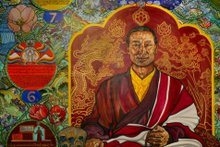
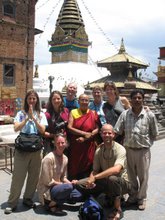



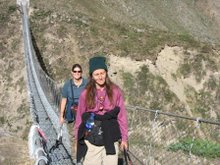
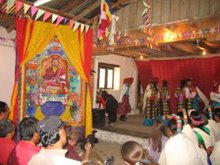
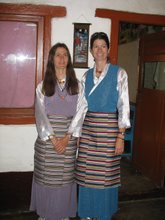


2 comments:
Love reading all the stories of your travels. Everything is fine at home. Everyone misses you and sends their love and purrs.
Barbara
Four days ago we celebrated my others birthday in Lier, Anna was there, smiling as always and telling about the great trip to Hollywood. Anna called my mother "MOR" -norwegian for mother/mum. They meet many years ago so I called Anna my sister in all the years we where lucky to have here around. I still can't get it in, that she's gone. May she rest in peace.
Post a Comment